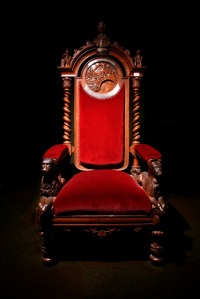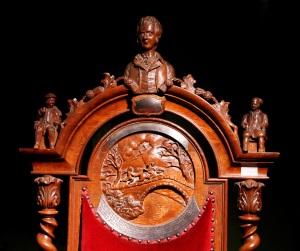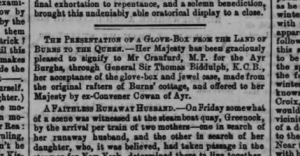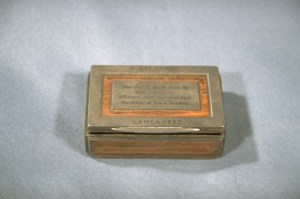Burns Cottage
An Awfie Symbolic Seat
Date: 1858
Object Number: 3.4521
On display: in the museum exhibition space
This remarkable chair is made of wood sourced from the Kilmarnock printing press which produced the first edition of Robert Burns’s work Poems Chiefly in the Scottish Dialect known as ‘The Kilmarnock Edition’. It was published on the 31st July 1786 at the cost of three shillings per copy. 612 copies were printed and the edition was sold out in just over a month after publication. The printing press no longer exists but in its stead there are two statues: one of Burns and one of John Wilson (the owner of the press) to commemorate the publication of Burns’s first works.

This chair was constructed in 1858, just before the Burns Centenary Festival in Ayr in 1859. The one hundredth year anniversary of the bard’s birth was celebrated far and wide by many. One contemporary counted 676 local festivals in Scotland alone, thus, showing the widespread popularity of Burns.

The chair has plush red velvet on the cushion and is elaborately carved with symbolism and references to some of Burns’s most loved works. Each arm rest ends with a carving of a dog, Luath and Caesar, from the poem ‘The Twa Dogs’.

A carving of Robert Burns himself, after the artist Alexander Nasmyth’s famous portrait – whereby he is shown fashionably dressed in a waistcoat, tailcoat and stalk – is placed in the centre at the highest point of the back of the chair with the infamous characters Tam and Souter Johnnie from the narrative poem ‘Tam o’ Shanter’ on either side. Thistles, commonly regarded as the floral national emblem of Scotland, decorate the gaps between the figures.

The central carving is of the climactic scene of Tam crossing the Brig o’ Doon atop of his trusty cuddie (horse in Scots) Meg with Nannie the witch at their heels. The Brig o’ Doon is actually a real bridge and is located in Alloway where Burns was born and lived for seven years.


A small plaque above this quotes a verse from Burns’s poem ‘The Vision’ which was written in 1785 and published in Poems, Chiefly in the Scottish Dialect. It takes the form of a poetic ‘dream vision’, a form used in medieval Scottish verse and revived by Allan Ramsay in his own poem ‘The Vision’, from which Burns takes his title and was influenced and inspired by immensely. In the long narrative poem, Burns as speaker returns from a hard day in the fields and, after resting by the fireside, falls into a dream state in which he is visited by Coila, a regional muse. Coila (whom the speaker is clearly attracted to) addresses Burns, describing how she watched his development from a young age – thereby offering an imaginative reworking of Burns’s emergence as a poetic talent. She ends with a confirmation of his poetic mission and crowns him as bard. The striking thing here is the self-consciousness Burns displays about his position even this early in his career.
The inclusion of these particular carvings could be symbolism of the themes in which Burns explored most through his works: nature with the dogs representing this; the supernatural via the Brig o’ Doon scene; comradery through Tam and Souter Johnnie the “drouthy cronie” and the nature of the self and humankind through the quote from ‘The Vision’ and Robert Burns himself.
Interestingly, during a visit to Burns Cottage in 1965, the boxing legend Muhammad Ali was pictured sitting in this chair. Following this visit he was made an honorary member of Alloway Burns Club. If you are intrigued by this then please read a previous blog by volunteer Alison Wilson about an extraordinary meeting to do with this celebrity visit to Alloway here: https://burnsmuseum.wordpress.com/2016/06/13/memories-of-muhammad-ali/.

By Parris Joyce, Learning Trainee.
The ‘Heaven taught ploughman’?
‘Though I am far from meaning to compare our rustic bard to Shakespeare, yet whoever will read his lighter and more humorous poems, … , will perceive with what uncommon penetration and sagacity this heaven taught ploughman, from his humble unlettered station, has looked upon men and manners. – Henry MacKenzie
At the age of 6, a young Robert Burns was sent to school at Alloway Mill to be taught by a William Campbell. The Bard’s father, William Burnes, was a great believer in his children’s education and wanted to ensure they received proper schooling. Unfortunately this was to prove tricky as Campbell the village left shortly afterwards. Not to be deterred, William Burnes approached Ayr Grammar School and requested a private tutor, John Murdoch, to teach his boys alongside 4 other families in the village, and to take turns to board in each of their houses.
Murdoch was a young man of eighteen himself, but struck up a firm friendship with William and enjoyed teaching the boys. Even after the family left Burns Cottage, they continued to attend Murdoch’s school in the village for two years. At this point, Murdoch left the area, but returned in 1772 and taught Robert Burns further, particularly French and English grammar. He also gifted him the works of Alexander Pope, whom Burns quotes frequently in subsequent letters and admired greatly.
Gilbert Burns wrote extensively on his former teacher, and credits him with inspiring Robert’s love of reading:
‘With him we learned to read English tolerably well; and to write a little. He taught us, too, the English grammar; but Robert made some proficiency in it, a circumstance of considerable weight in the unfolding of his genius and character; as he soon became remarkable for the fluency and correctness of his expression, and read the few books that came in his way with much pleasure and improvement; for even then he was a reader when he could get a book. Murdoch, whose library at that time had no great variety in it, lent him the Life of Hannibal, which was the first book he read (the school-books excepted), and almost the only one he had an opportunity of reading while he was at school.’ – Gilbert Burns
Murdoch himself wrote of his time teaching the Burns boys, in which he was less than complimentary about the Bard’s singing abilities, and confesses that he would have thought Gilbert more likely to develop into a famous poet:
‘Robert’s ear, in particular, was remarkably dull, and his voice untunable. It was long before I could get them to distinguish one tune from another. Robert’s countenance was generally grave and expressive of a serious, contemplative and thoughtful mind. Gilbert’s face said, “Mirth with thee I mean to live”; and certainly if any person who knew the two boys had been asked which of them was most likely to court the Muses, he would surely never have guessed that Robert had a propensity of that kind.’ – John Murdoch
In 1776, a complaint was made against John Murdoch that he had insulted the local church minister, William Dalrymple, and the former was forced to leave the village. He moved to London, where he actually assisted with the funeral arrangements of Burns’s younger brother William, who he had met with shortly before William’s death. Unfortunately for Murdoch, he died himself in 1824 in extreme poverty.
Thanks to the determination of his father and the dedication of John Murdoch, Robert Burns received a considerable formal education in his youth. This fostered his love of literature, and allowed him to develop the social and political knowledge necessary for writing some of his greatest works. Far from being a ‘heaven taught ploughman’ as MacKenzie suggests in his review of the Kilmarnock Edition in 1786 (see top of blog), Robert Burns received excellent schooling for the time, and was able to put this to full use during his adult life.
New Gardens
In 1756 a farmer and landscape gardener called William Burnes took a perpetual lease on a 7 acre piece of land in Alloway. The next year, he started work on a small Cottage for himself and his wife, Agnes, and two years after that their first son Robert was born in its kitchen. 37 years later, Robert Burns died in Dumfries having cemented his place in history as Scotland’s National Bard.
William was an innovator. He had previously worked on the laying out of Edinburgh’s Hope Park (now the Meadows) and believed in agricultural and landscaping improvement. Although they only lived at Burns Cottage until young Robert was 7, it was always William’s dream to create a self-sufficient market garden, ‘New Gardens’ on the site. Unfortunately, his idea did not prosper and over time the land was given over more and more to cattle and poultry. It was with this in mind that the Robert Burns Birthplace Museum (RBBM) team decided to revisit William’s plans and restart ‘New Gardens’ as a working project.

The first steps were taken last year, with the planting of a 39 tree strong orchard which is already bearing fruit. Last week saw the beginning of the next stage of works, carried out by W L Straughan & Son Ltd, to install raised beds, public walkways, and a pond and wetland area. With this, we aim to improve biodiversity onsite, expand on the outdoor learning opportunities (for schools, families and community groups) RBBM currently offers, and to realise William’s ‘New Gardens’ vision and offer up an historic continuum on this plot of land between the time of Burns and the present.
In 1765, William Burnes leased land at Mount Oliphant farm about 2 miles away from Burns Cottage in Alloway, and the family moved there. Soil was poor and the family had to work hard to keep afloat. 12 years later, they moved to Lochlea Farm in Tarbolton, site of the Bachelors’ Club where Robert Burns learnt to dance, founded a debating society, and joined the Freemasons. Unfortunately, the family continued to find it difficult to make ends meet, and became involved in a legal dispute with their landlord. They eventually won the court case in 1784, but William was left physically drained and died just a few weeks afterwards.

233 years later, his New Gardens project is now underway at the Burns’s first family home in Alloway, and will allow RBBM to focus on another of William’s key passions – education – without which the boy born in 1759 in the kitchen of the auld clay biggin’ may never have gone on to become Scotland’s National Bard.
Memories of Muhammad Ali
Volunteer Manager Alison Wilson tells us about an unexpected and exciting experience that she had whilst guiding a tour of the museum on Saturday.
I had an amazing experience at the museum on Saturday. There I was, standing at the chair made out of John Wilson’s Kilmarnock printing press which produced the first edition of Burns’s Poems, ‘Chiefly in the Scottish Dialect’ giving it big licks to a group of 15 Americans all about how Muhammad Ali had once sat on it when he visited the cottage in 1965. There is a famous photo of the boxing legend sat in the chair surrounded by fans and I heard that the boy stood nearest Ali in the photo was in the museum that day.
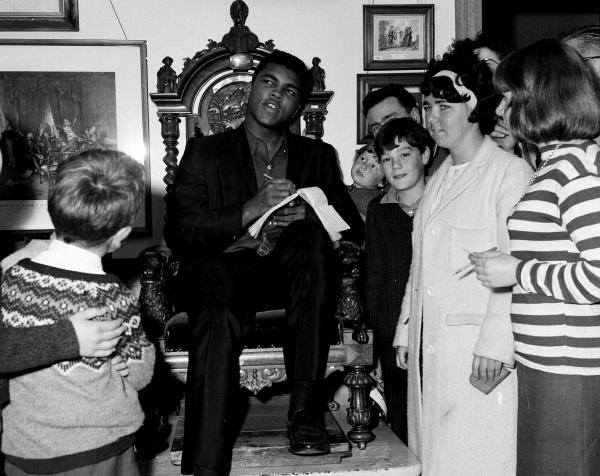
Eventually, with the aid of Ros at the shop, we found the boy from the photo eating his lunch in the cafe. Now a fully grown man, George Spence from Dreghorn was visiting the museum with his wife and grandchildren. He needed little persuasion to have his photo taken next to the original photo of himself at the age of 13 with Muhammad Ali.

George had met Muhammad Ali over 50 years ago during the summer holidays when his father was on shifts. His mother, he said, “made him get up and take them to Burns cottage” as she’d heard Muhammad Ali was coming. When they arrived it seemed to the young George that hundreds of people were milling around on the grass at the back of the cottage trying to get a glimpse of the Heavyweight Champion of the World. George’s canny mother, however, realised that the great celebrity would sooner or later go into the cottage itself. “She grabbed us and pushed us in to the cottage”, he remembered. Whereupon the door slammed shut. George with his wee three-year-old sister, mother and father were inside with just a few others. Suddenly the door burst open and in swept Muhammad Ali with his entourage and all the press.
Ali then stepped over the barrier and sat on the seat pretending to write one of his legendary poems just like Robert Burns. He joked, “Bobbie Burns will be looking down seeing me sitting in his chair”. He spoke to George personally asking if he would like to be a fighter like him.
As you can imagine, George told this story as if it had happened yesterday and it was such a privilege to listen to such a brilliant story about an important part of the recent history of Burns Cottage. George had only recently discovered the photo of himself with Ali on the internet but had cherished the memory of meeting the great man ever since. I only hope he found his return visit to the scene memorable too.
Rag Rug Making
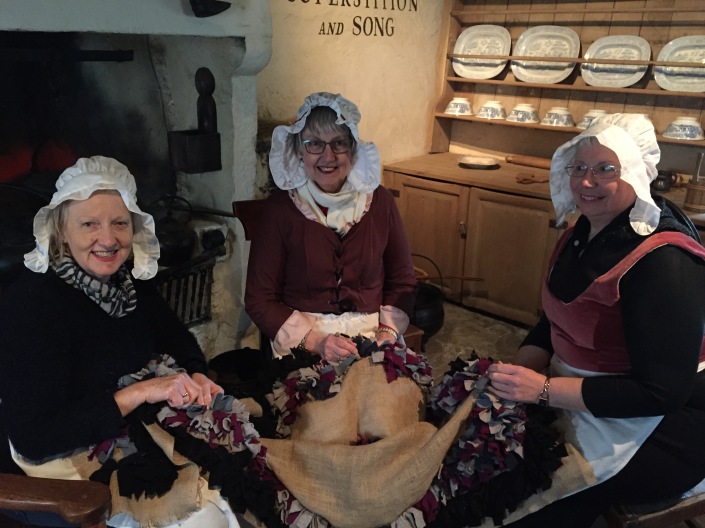
Recent visitors to Burns cottage may have noticed something new. Our volunteers have been spending time demonstrating different 18th Century crafts inside the cottage. These crafts are all skills women in the 18th century would have been very familiar with and it is easy to imagine Agnes Burnes (Robert Burns’ mother) toiling away at these chores over the course of the day in the cottage.

One of the crafts underway is a project to make new rag rugs for the cottage. A group of volunteers have been busy starting this process over the winter and have just begun to demonstrate their new skills to visitors.
Rag rugs were popular because they were easy to make and materials were cheap. All you need to make your own is some hessian and lots of scrap material. Our volunteers started with a large hessian lining which would make up the back of the rug. Their first task was to draw a border which they wanted to fill with black material. Using old clothes kindly donated to us, our volunteers cut the material into strips to add to the rug.
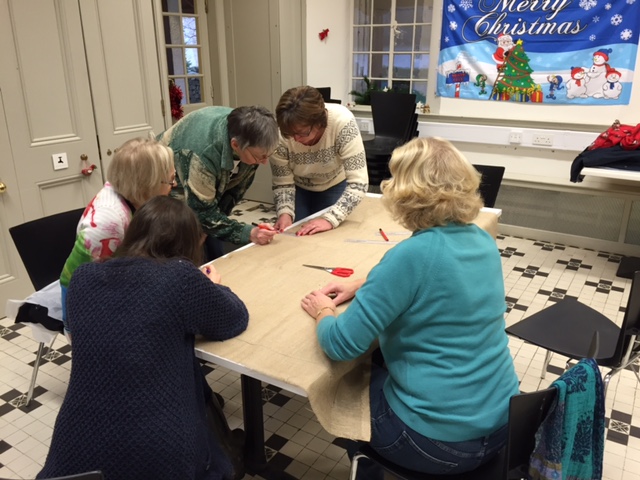
The process is very simple: the material is simply pushed through the hessian using wooden pegs and because the material is tightly packed together it will stay in place.
The volunteers have now finished the black border and have been adding the colourful material to the centre of the rug. The material used for the rugs needs to be quite hard wearing and wool cloth is best; this makes the rugs heavy and warm.
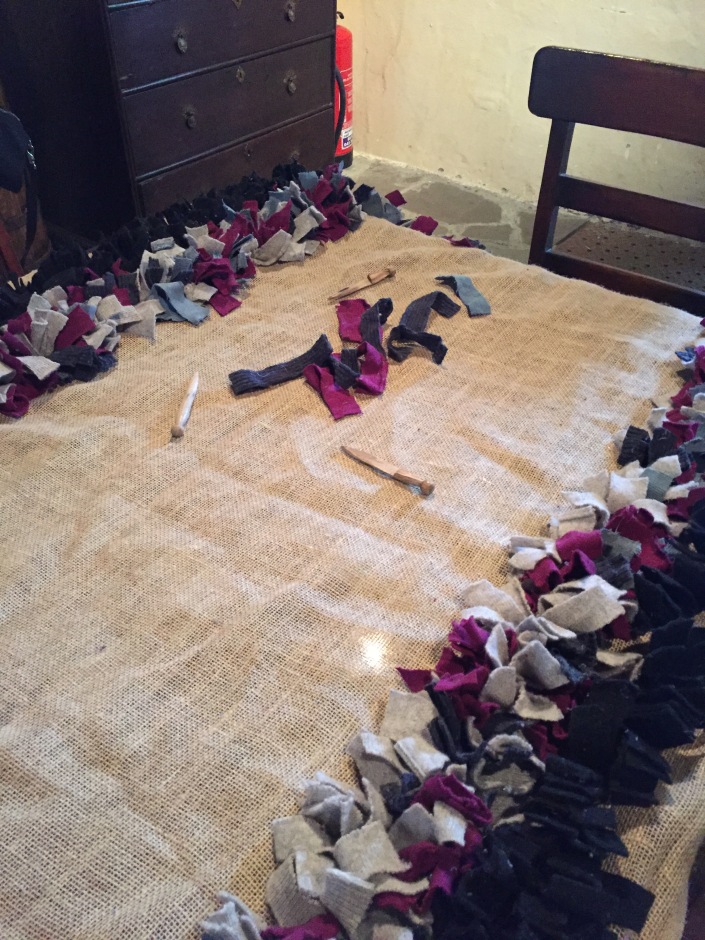
The rag rug team will be demonstrating their crafts on Monday afternoon and we recommend popping in to watch them in action!
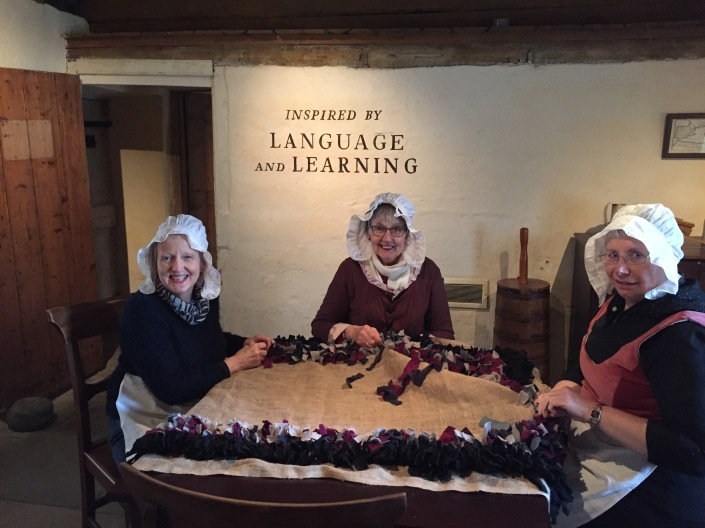
“Alloway’s Auld Kirk” Research Project
When I started as a volunteer and just walked around the Kirk yard I wanted to know more about the Kirk and the people who were buried there. During a tour someone asked me about a headstone, and this started the project of writing down the 219 headstones so I could learn more and be able to answer the any questions.
It started off as just a project to learn more, but it has now become more involved with research of many families, guided tours, and talks on the Kirk yard. It has taken a year to finish it, with the Kirk yard laid out as is on an A1 sheet of paper.
The most well known headstone is of course William Burnes, the flat stone in front is very worn, but it is the resting place of Isabella Begg (Robert Burns’ youngest sister and two of her children Agnes and Isabella, they were all in their 80s when they died.
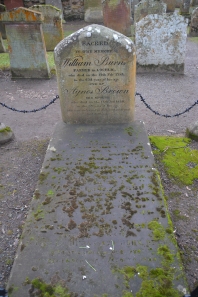
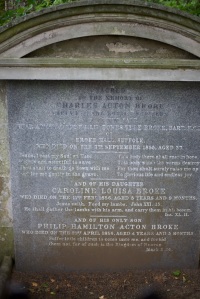
Do you have a favourite headstone (or stones!)
One is a headstone in remembrance of Charles Acton Broke who was the son of Rear Admiral Sir Philip Bowes Acton Broke. This man was a Captain of a ship during the war with the Americas in 1812, and was the first to defeat and capture an American ship.
There are two headstones of people who died in their 100th year!
My favourite one I cannot read the writing, but on the reverse are two fluted panels with a heart and a tear in each corner. I would love to know who they were.
Also the headstone of John Tennant, as there is so much detail on the stone which I have great pleasure in relating to visitors.
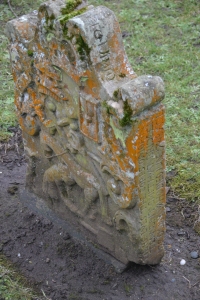
The next step in the research is to write out a Kirkyard plan based from a survey done in 1995 , when completed you will be able to compare the difference in the headstone conditions between 1995 and 2015 many of which are completely eroded.
Sandy
The Man of the Hour
Over the 19th century many families lived in Burns Cottage, running the house as a pub. Of some families we know little – names and dates, and not much more. Others, however, have been full of such characters that they have left their mark on history. One of these characters, the head of the last family to reside in the cottage, lived an eventful life that has been recorded by many historians. This man, Thomas Morley, has been described by historian Tom Quinn, who stated that ‘Morley was not just addicted to war, he was also addicted to the idea that he was a great man.‘

War shaped much of Morley’s life as he spent many years as a soldier. Born around 1831 in Nottingham, he joined the 17th Lancers as a young adult and fought in the Crimean War, surviving the charge of the Light Brigade during the battle of Balaclava in 1854. This event quickly became famous, catching the public emotion, as the men were ordered to charge towards a line of Russian guns with an extremely high fatality rate. Thomas Morley recorded his own experiences in a book he wrote in 1896, The Cause of the Charge of the Light Brigade. In this account he describes the loss of life stating that, ‘I am only certain of the figures for my own regiment. The 17th Lancers went into the engagement 145 and came out 45 mounted. Every officer of my squadron was killed or wounded.’

Morley became quickly aggrieved that his heroics in this battle went unrewarded and he is famed for writing continual letters, from 1857 to 1896, to the Queen and military officials asking for his actions to be honoured by a Victoria’s Cross. In order to substantiate his claim, he accrued accounts of fellow soldiers, such as this one from J.W Wightman:
‘We heard the familiar voice of Corporal Morley, of our regiment, a great, rough, bellowing man from Nottingham. He had lost his lance hat, and his long hair was flying out in the wind as he roared, ‘Coom ’ere! coom ’ere! Fall in, lads, fall in!’
Despite his disappointment in his post war treatment and his consequent early retirement from the 17th lancers, Morley voluntarily fought in the American Civil War for the Union side. During the war he became a prisoner inside the infamous Libby prison, an experience he recounted afterwards for the Washington Post:
‘During the time I was prisoner of war, General Cesnola saw me compelled to be vaccinated. The matter turned out bad, my left side and arm swelled to such a degree that I was compelled to lie on the floor for months, my brother officers believing I should die.”
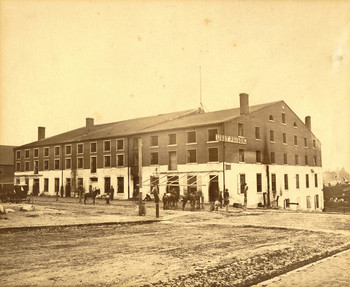
http://www.encyclopediavirginia.org/media_player?mets_filename=evm00001711mets.xml
Morley survived his experience though, and after the war he moved to Ayrshire where he was employed as drill troop sergeant in the Ayrshire Yeomanry, and lived at the Auchengree Foundry with his wife Katherine and his children. It is not until the late seventies that Morley took on the lease of Burns Cottage (a photo of the cottage in his time can be seen here) where he lived with his new (and much younger!) wife and his children, two of which were born in the cottage. His war experiences are very much revealed in the names he gave his children, Cesnolia and Cesnola after a Brigadier General from the Civil War, and Balaclava from the Crimean War!
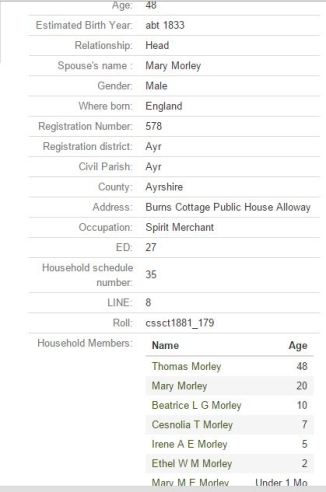
Following their time at the cottage, Thomas Morley returned the States where he worked in the War Department housed at Ford’s Theatre. Three of his children were born in Washington DC and, sadly, 17 year old Cesnola died there in 1890. Another family tragedy occurred in 1893 when Thomas Morley himself was injured in the collapse of Ford’s Theatre and was, from then on, unable to work. The family returned to Britian in 1897 and Thomas Morley lived with his family in Nottingham until his death in Nottingham City Asylum in 1906.
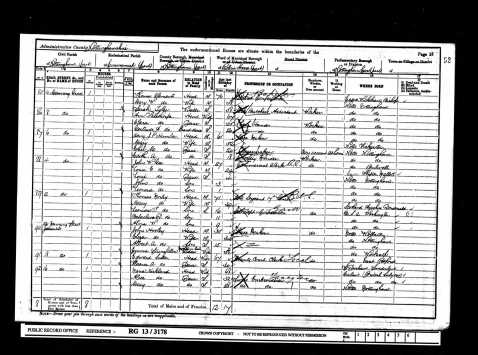
The descriptions we have of him seem to suggest a strong, brave, stern man with a distinct northern English accent and with perhaps a tendency to self publicise and to wax lyrical about his military achievements and lack of official recognition. Of what happened to his children, little has yet been researched, though of Balaclava Morley we know that he decided to live in the U.S.A, where he died in Gardena, Los Angeles, in 1978.
#ilovemuseums because of the unique collections!
A previous blog post looked at the ‘up-cycling’ of the press that printed Burns’s first collection of Poems Chiefly in the Scottish Dialect also known as the Kilmarnock Edition. The repurposing of the press happened in 1858 and it was turned into an arm chair. The chair became an ornamental and useful piece of fine oak furnature, that was a souvenir or relic of Burns’s inaugural work.
This is not only one example of creating souvenirs or relics relating to Burns’s work and life from materials which are linked to aspects of his fame and life. At the Robert Burns Birthplace Museum and Bachelors Club, Tarbolton there is an amazing array of material! This blog post will look at a few highlights in the collection.
From the passing of Robert Burns on the 21st of July 1796 at the age of 37 people wanted to own a piece of the man! Over the years after his death the “Burnsiana”[1] grew and developed, the collection of Burns souvenirs is broad and includes material that has been up-cycled from other objects or materials include pieces of Burns Trysting tree made into collectables, hair jewellery made with pieces of Jean Armour’s hair and pieces of Burns’s kist/coffin.



An interesting item in the museum collection is a necklace that is in the Fame section of the museum display. The necklace has 40 wooden beads and a wooden cross at the front with metal embellishments. It is 54cm long and the wood used in the necklace was taken from the Auld Alloway Kirk, just a short walk from Burns Cottage and next to the Burns Monument.
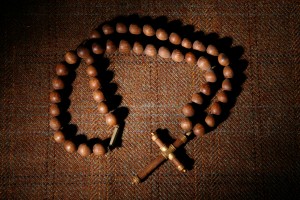
Alloway Kirk is a ruined church, which was built about 1516. By the time Burns wrote Tam O’Shanter the Kirk was in ruins. It had not been used for several decades and was in a ruinous state.
There is little information within the object record other than that the necklace is dated to 1822 – which dates to when Burns Cottage was under the tenancy of John Gaudie, and when the Burns Monument was under construction.
Other unique wooden souvenirs in the collection include a Pipe Case reportedly made from part of Burns’s Kist (3.4572), this is not unusual in the sense that it is connected with Burns’s burial – with the acquisition dated to 1834, below is an image of a piece of wood taken from Burns’s coffin when his tomb was opened so that Jean could be buried alongside him.
As with many souvenirs or relics the authenticity of the object is unclear – in this case eyewitness accounts state that the coffin was intact.
Wooden souvenirs with a direct connection to Burns’s life, made from the wood of trees grown on the banks of the Doon or, in this case, from the rafters of Alloway Auld Kirk, were highly sought after by Burns enthusiasts and general Victorian collectors.
In the 19th century there was a real interest in relic collecting relating to contemporary Poets – for instance at Keats House, Hampstead has in the collection a Gold Broach with some of Keats’s hair displayed in it, c.1822 (K/AR/01/002); another relic kept by the British Library is Percy Shelley’s ashes set inside the back cover of the book Percy Bysshe Shelley, His Last Days Told by His wife, with Locks of Hair and Some of the Poets Ashes (MS 5022).[2]
At RBBM we have a lock of our Poet’s hair which is said to have been snipped from Robert’s head shortly after his death by his wife, Jean Armour, and given to her friend Jean Wilson in Mauchline as a macabre souvenir.
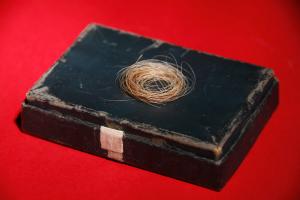
The world of Burns souvenirs and relics is vast and this only highlights some of the more unique… and interesting aspects of Burnsiana!
[1] Mackay,.J.A Burnsiana (1988)
[2] Lutz,.D Relics of Death in Victorian Literature and Culture (2015).
by Catriona, Learning Intern
Upcycling Burns
This chair was made in 1858, just before the first centenary of Robert Burns’ birth. It is constructed from wood taken from the Kilmarnock printing press which produced the first edition of Burns’s Poems, Chiefly in the Scottish Dialect.
John Wilson, owner of the only printing press in the area, was a friend of Robert Burns and a statue of the two of them can be found in the location of the original printing press site. A copy of the printing press can be found in the Dick Institute, in Kilmarnock.
The carvings on the chair depict Luath and Caesar, from the poem The Twa Dogs.
In the centre of the high back you can find a carving of the Bard, after Naysmyth, with two of his most iconic characters, Tam O’Shanter and Souter Johnny on either side. In the centre there is a bas-relief carving showing Tam being chased by the with over the Brig O’Doon. Above this carving you can find a plaque with quotes from Burns’s poem, The Vision. On either side are spiral twist uprights which frame the carving. The chair is upholstered in a red velvet material which also covers the arm rests.
The history of the chair dates back from when the wood which is made of was part of the Kilmarnock Printing Press. Walter Graham had been John Wilson’s pressman for more than 40 years and he had worked on the first printing press brought into Ayrshire (thought to be that of Peter McArthur). The press which Graham had worked moved to Ayr and was used at the Wilson’s business until replaced by a more efficient machine.
It was in 1858 that Thomas M Gemmell, proprietor of the Ayr Advertiser (which had also been printed using the same press), decided to convert the press into an arm chair, wanting to create something ornamental and useful out of the fine oak.
Following Thomas M Gemmell’s death in 1889, the chair was presented to the Trustees of the Burns Monument. It was displayed in the Burns Cottage Museum and for a period of time was undergoing conservation treatment. It is now in museum stores, with the hope of displaying it later in the year.
In 1965 Burns Cottage welcomed a special guest. Muhammad Ali visited when he was in Scotland to fight Harvey ‘Cody’ Jones in Paisley. The World Heavyweight Champion fancied himself as a bit of a poet. He didn’t disappoint – as he sat in the cottage signing autographs and talking to the press he came up with this:
‘I’d heard of a man named Burns – supposed to be a poet;
But, if he was, how come I didn’t know it?
They told me his work was very, very neat,
So I replied: ‘But who did he ever beat?

Re-purposing and ‘up-cycling’ objects relating to Burns is an old tradition: here we have another chair, which is held in a private collection. Made in 1818 from the remains of the oak that composed the old roof of Alloway Kirk. Presented to Hugh, 12th Earl of Eglinton, it has references to the poet’s work.
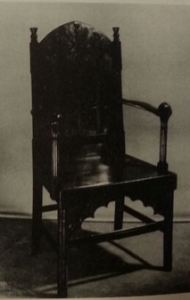
The front seat rail features an inlaid plough and the inscription ‘In memory, Robt. Burns’. The brass panels are engraved with the poem Tam O’Shanter and signed Robb McWhinnie, Sculp, Ayr. (McWhinnie was an engraver and watchmaker in Ayr. Two cabinet makers – Jno. Underwood and Jas. Loumgair were responsible for its creation. The original home of this Burns chair was Eglinton Castle, Ayrshire, rebuilt in the Gothic ‘Castle Style’ by John Paterson 1798-1803.
Other upcycled objects include a glove box and jewel case, and a snuff box, made from the the original rafters of Burns Cottage and from an oak rafter from Alloway Kirk respectively.
Our most recent object which has been upcycled however can be found on Poet’s Path. The RBBM volunteers have worked hard to re-use some pallets to create a lovely bench which visitors can use when waiting on the buggy and read a selection of great books, stored in a handy section of the bench!





